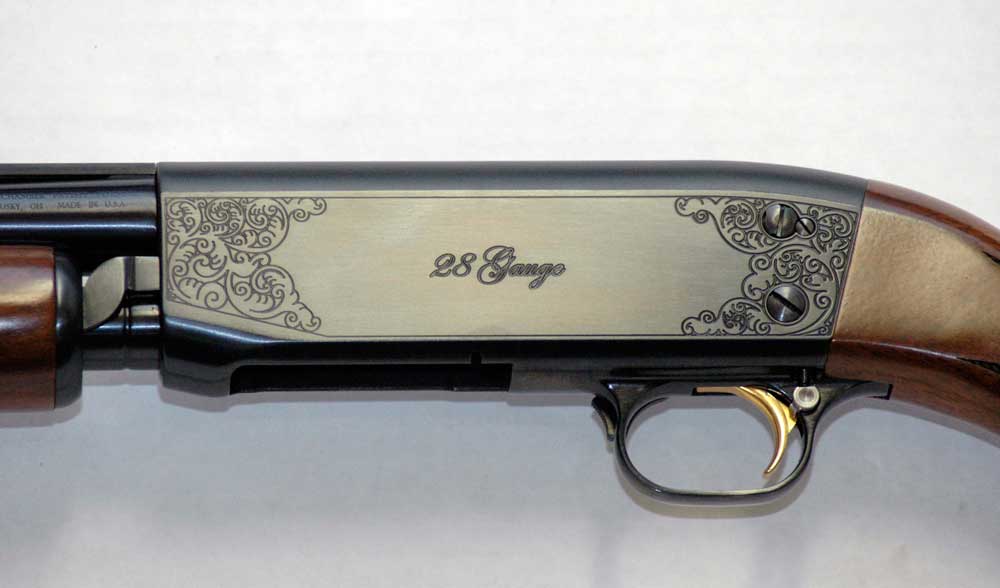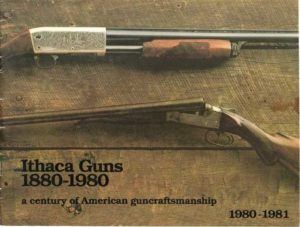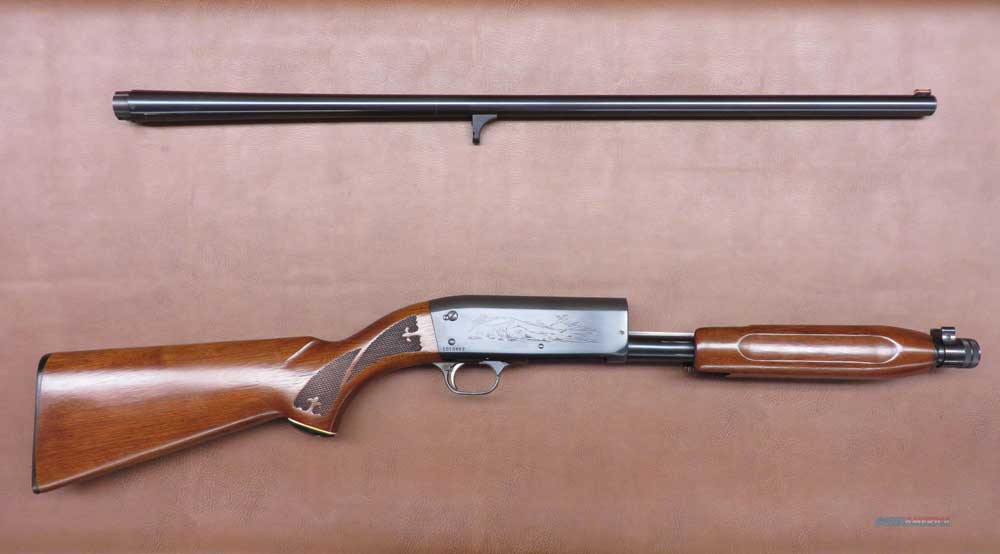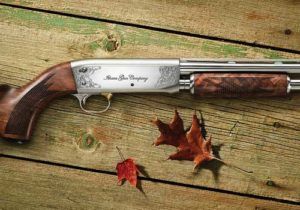
A survivor of 80 years on the shotgun scene, the Model 37 remains a dependable and classic option for hunters and sporting shooters.
What to know about the classic Ithaca Model 37 pump-action shotgun:
- The Ithaca Model 37 has had the longest production run of any pump-action shotgun.
- The Model 37 was based on a patented John Browning design.
- More than two million Model 37s have been produced over its 80-year history.
- This pump-action, bottom-ejecting shotgun is available in a number of configurations.
The pump-action shotgun has been the favorite choice of many American hunters for well more than a century. Its popularity is widespread with all types of shooters and for any shotgunning applications, including hunting, competitive shooting, self-defense, law enforcement and the military. The pump, or slide-action, can do any job well.
Generation after generation, the pump-action remains a favorite scattergun for a variety of reasons. It’s the go-to gun for those shooters who prefer its simple design over the more complicated autoloaders and the pricey doubles and over/unders. Many shooters prefer the sighting plane of a single-barrel shotgun. America has been called a nation of riflemen, and those who learned how to shoot with a rifle are likely to be more comfortable sighting down the rib of a shotgun with one barrel.
 The same can be said for the semi-auto, but the self-loading guns aren’t for every shooter. There are several different types of semi-auto actions, but all have a more complicated operating system that can be more troublesome than a pump. They tend to be heavier and are not as easy handling in the field. Gas-operated actions are dirtier due to the burnt powder that accumulates and they generally require more maintenance and cleaning. The recoil-operated autos are cleaner but some, especially the older long-recoil designs, have more of a kick than either the gas guns or pumps.
The same can be said for the semi-auto, but the self-loading guns aren’t for every shooter. There are several different types of semi-auto actions, but all have a more complicated operating system that can be more troublesome than a pump. They tend to be heavier and are not as easy handling in the field. Gas-operated actions are dirtier due to the burnt powder that accumulates and they generally require more maintenance and cleaning. The recoil-operated autos are cleaner but some, especially the older long-recoil designs, have more of a kick than either the gas guns or pumps.
Some shooters prefer the manually-operated pump because they want to be more in control of the gun’s operation. They may not truly trust a semi-auto and are comforted by the simplicity of a pump. And it’s a safety concern with some shooters. Fire a pump gun and the chamber isn’t reloaded until you “rack the slide.” Fire an autoloader and, if there’s ammo in the magazine, you instantly have another round in the chamber ready to go — with your finger on the trigger. This is not always a good thing, especially with an inexperienced shooter.
At one time, there were predictions that the autoloader would someday replace the pump gun. That obviously hasn’t happened, and today, some 120 years after the first successful slide-action went on the market, the good old pump still plays a big role in the shotgun sports.
 The Dawn Of The Pump
The Dawn Of The Pump
That first successful pump-gun was the Winchester Model 1897, which was an improved variant of the Model 1893. It should come as no surprise to a reader of this publication that both designs came directly from the fertile mind of John M. Browning.
The 1893 was caught between two eras in firearms history, the end of black powder and the beginning of smokeless powder. It was designed to be used only with black powder, and after it was on the market for a short time, Winchester had John Browning beef up the receiver and make several internal changes to enable the gun to handle the smokeless propellant’s higher pressures.
By 1897, Winchester had made and sold about 30,000 Model 1893s. With the growing popularity of smokeless powder, and to avoid any injuries and lawsuits, the company did what might have been the first recall by a firearms manufacturer. Ads were bought in outdoor magazines asking owners of 1893s to send their shotguns to Winchester and be replaced by a new one, the Model 1897. This was free of charge and, while exact numbers aren’t available, many Model 1893 owners took advantage of the offer.
The Model 97, as it was later known, became the most popular shotgun in the country. More than one million were produced over its 60-year life-span between 1897 and 1957. It was made in several variations, including a riot-gun model with a 20-inch barrel that became popular with many law enforcement agencies. A similar model, known as the Trench Gun, was made for the military during WWI. This rare variation is very popular with collectors.
 The 97’s first serious competition in the pump gun category was its sibling, the Winchester Model 12, introduced in 1912. It was one of the streamlined “hammerless” (internal hammer) designs that soon took over the pump-action shotgun world.
The 97’s first serious competition in the pump gun category was its sibling, the Winchester Model 12, introduced in 1912. It was one of the streamlined “hammerless” (internal hammer) designs that soon took over the pump-action shotgun world.
The next pump gun to give both the Model 12 and the 97 serious competition was the Ithaca Model 37. It, too, was based on a John Browning design. He had patented a pump shotgun in 1915 that was somewhat radical because its ejection and loading port was located beneath the receiver. This feature gave the gun a solid receiver that protected it from the elements and prevented twigs or other debris from getting into the action. Since the loading port for the magazine was at the bottom of the receiver and the spent shells ejected from the same location, the design appealed to both right- and left-handed shooters.
Browning sold this patent to Remington, and the plan was to put the new gun on the market in 1917 as the Model 17. However, due to interruptions of civilian gun production during the First World War, it was 1921 before Remington could begin manufacture of the new gun. About 48,000 Model 1917s were manufactured by the time it was discontinued in 1933 and replaced by the side-ejecting Model 31, which later evolved into the Model 870.
The Rise Of The Model 37
Meanwhile, the Ithaca Gun Company wanted to get into the slide-action shotgun business. Well known for its line of high-quality side-by-side doubles, the company saw a bright future for the less expensive pump models. The Winchester Model 12 had become very popular and was setting the standard for pump-action shotguns. The management at Ithaca wanted to give the Model 12 some competition. They were intrigued with Remington’s Model 17 and wanted to produce a similar gun.
The decision was made to wait until the patent for the Model 17 expired in 1933, at which time Ithaca would introduce a new bottom-ejection slide-action to be known as the Model 33. However, plans changed when Ithaca became aware of a patent obtained by designer John Pedersen for an improved version of the Remington Model 17, which was due to expire in 1936. Ithaca once again pushed back its plans for a pump gun.
There was time to have gun designer Harry Howland make some changes to the firing pin and ejector mechanism and, by 1937, Ithaca was ready to introduce the Model 37 to the shooting world. The Model 37 was a big success and went on to have the longest production run of any pump-action shotgun, surpassing that of the Winchester Model 12 — which had inspired the 37’s very existence. More than 2 million Model 37s have been produced over the gun’s 80-year history.
 Like most of the old-line gunmakers of the 19th century, Ithaca has an interesting and complicated history. The company was founded in Ithaca, New York, in 1880 by partners William Henry Baker, Dwight McIntyre, John Van Natta and Leroy H. Smith. Mr. Smith was a brother of L.C. Smith, founder of the legendary double-barrel shotgun company that bore his name. When Leroy Smith died in 1902, he left his share of the company to his son, Louis, who for 17 years was Ithaca’s only salesman. He worked his way up to become president of the company and later was mayor of the city of Ithaca, New York.
Like most of the old-line gunmakers of the 19th century, Ithaca has an interesting and complicated history. The company was founded in Ithaca, New York, in 1880 by partners William Henry Baker, Dwight McIntyre, John Van Natta and Leroy H. Smith. Mr. Smith was a brother of L.C. Smith, founder of the legendary double-barrel shotgun company that bore his name. When Leroy Smith died in 1902, he left his share of the company to his son, Louis, who for 17 years was Ithaca’s only salesman. He worked his way up to become president of the company and later was mayor of the city of Ithaca, New York.
Ithaca soon established itself as a major player in the firearms history. By 1924 Ithaca was making more than 50,000 guns per year, which was a lot for that period. During World War II, the government contracted with Ithaca to produced 1911A1 pistols, and at one time the company was making more than 2,000 pistols per day. More than 300,000 of the .45-caliber guns were made by Ithaca during the war.
In the 1960s, changes began to occur at the company. A Colorado company, Baldritch & Associates, bought Ithaca in 1967. It later became General Recreation Inc., which added general sporting goods, outdoor clothing and catamarans to its line. At that point, Ithaca was no longer a gun company.
In the early ‘70s the company went public and within a few years ran into financial troubles, sold off everything except Ithaca, and filed for Chapter 11 bankruptcy in 1978, closing the plant for several months. General Recreation again filed for bankruptcy in 1985. Ithaca Acquisition took over the company and moved all the manufacturing to King Ferry, New York.
In 1987, the name of the Ithaca 37 shotgun was changed to the Model 87. Other than the name change, it was the same gun. The company changed hands again in the mid ‘90s, which changed the name of the pump gun back to the Model 37, and moved Ithaca Gun Co. LLC to Upper Sandusky, Ohio, where it remains today, turning out high quality Model 37s, 1911s and several variants of a high-grade rifle.
 Evolution Of The Model 37
Evolution Of The Model 37
The Model 37 operates in much the same way as other pump-action shotguns. After loading the shells into the magazine and pressing the slide release located in the forward part of the trigger guard, rack the slide and push it forward, loading the chamber. Firing the gun by pulling the trigger releases the fore-end slide so it can be pulled to the rear to eject the spent shell and then pushed forward to quickly load another round into the chamber.
In the current catalog, you will find the Featherlight, Defense Gun, Deerslayer II, Deerslayer III, Turkey Slayer, Waterfowl, Trap Model, Women’s Stock and 28 Gauge. Other special models over the years have included the Military & Police, English Style with a straight grip, Sporting Clays, Grouse Special, Hogslayer, Home Defense, Rifled Deluxe with a rifle barrel for slugs, Magnum, Bicentennial and others.
Several big-city police departments, including New York City and Los Angeles, issued the 12-gauge, 20-inch barrel Military & Police Model to patrol units for many years. The M&P Model served our troops well in World War II, the Korean Conflict and the Vietnam War.
In addition to those mentioned, there have been various high-grade models with hand-engraving gold inlays and highly figured walnut stocks. There is significant collector interest in some of the above models, especially the high-grade presentation and military-marked tactical guns.
The receivers of today’s Model 37s are made the way they were made years ago, from a solid block of steel. Modern CNC technology means that the machined parts are made more precisely than ever. Ithaca likes to make it clear that every part is made and assembled in the U.S.A.
Another feature of today’s Model 37 is that no soldering or brazing is used in the manufacture of the barrel. Lugs that are machined out of the barrel’s original steel block create what Ithaca calls the “truest, strongest barrel you will ever shoot.”
Stocks and fore-ends have laser-cut checkering and a nice red/brown stain, which brings out the grain of the fancy walnut. Grades are available in Fancy A, Fancy AA and Fancy AAA levels. Comb and length dimensions differ for the various models, and if specific measurements are needed, the Ithaca Custom Shop will provide. Standard dimensions are a 1.5-inch drop at comb, 2.25-inch at heel and a 14.25-inch length of pull, reduced to 14 inches for the 28 gauge. Each stock has a black Pachmayr Decelerator recoil pad.
 Today’s Model 37 is available in 12, 16, 20 and 28 gauge. The 28-gauge guns are built on a smaller receiver, which gives the model the easy handling and trim appearance one would expect for the gauge. Barrel lengths for 12-, 16- and 20-gauge guns are 26, 28 or 30 inches, and for the 28 gauge, 26 or 28 inches, all with lengthened forcing cones for better patterns and reduced recoil.
Today’s Model 37 is available in 12, 16, 20 and 28 gauge. The 28-gauge guns are built on a smaller receiver, which gives the model the easy handling and trim appearance one would expect for the gauge. Barrel lengths for 12-, 16- and 20-gauge guns are 26, 28 or 30 inches, and for the 28 gauge, 26 or 28 inches, all with lengthened forcing cones for better patterns and reduced recoil.
All barrels are steel-shot compatible, and current Model 37s come with three Briley choke tubes in full, modified and improved cylinder; a red TruGlo front sight; gold-plated trigger; and a five-round magazine capacity, with a plug to reduce it to 2+1 where required. Weights are listed at 7.6 pounds for the 12 gauge, 7.4 pounds for the 16, 6.8 pounds for the 20, and 6.1 pounds for the 28 gauge.
Suggested retail prices start at $784 for the Home Defense models, $895 for the standard hunting models, $1,020 for the trap guns, $1,145 for 28 gauges, and $1,150 to $1,350 for the Deerslayer models, depending on features.
I’ve owned quite a few shotguns over the years — over/unders, side-by-sides, autoloaders and pumps. In my safe I still have my 20-gauge Model 37 from 1960, which was my first shotgun and is still my favorite.
Editor's Note: This “Collector's Corner” column is an excerpt from the November 2017 issue of Gun Digest the Magazine.

Next Step: Get your FREE Printable Target Pack
Enhance your shooting precision with our 62 MOA Targets, perfect for rifles and handguns. Crafted in collaboration with Storm Tactical for accuracy and versatility.
Subscribe to the Gun Digest email newsletter and get your downloadable target pack sent straight to your inbox. Stay updated with the latest firearms info in the industry.

![Best Concealed Carry Guns In 2025 [Field Tested] Wilson Combat EDC X9S 1](https://gundigest.com/wp-content/uploads/Wilson-Combat-EDC-X9S-1-324x160.jpg)


![Best 9mm Carbine: Affordable PCCs [Tested] Ruger Carbine Shooting](https://gundigest.com/wp-content/uploads/Ruger-Carbine-Shooting-100x70.jpg)
![Best AR-15: Top Options Available Today [Field Tested] Harrington and Richardson PSA XM177E2 feature](https://gundigest.com/wp-content/uploads/Harrington-and-Richardson-PSA-XM177E2-feature-100x70.jpg)

Buyers beware : My son bought a brand new, in the box, model 37 Featherlight 16 ga. pump from an Ithaca dealer in or around 2012-13. It jammed from the first day he used it. I bought my model 37 12ga. directly from the factory outlet store in 2016 after calling and asking if they have fixed the problem. The person I talked to said “this is the first I have ever heard of any problems with this shotgun”. This was a big lie, as my son had sent his back twice. It also jammed right out of the box and for the same reason : Problem : When the gun is fired and the spent casing is expelled, two more rounds slide out of the mag at the same time. The first new shell lands onto the guide arms like it should. Then as the shell is lifted up toward the chamber, another shell slides out of the magazine under the guide arms preventing closing of the bolt face. To clear the jam, I must force the second shell back into the magazine and then close the bolt face. Both shotguns have exactly the same malfunction right out of the box. My son sent his back to Ithaca and got it back without any explanation or improved results. He sent it back a second time and got it back again without any explanation and very little improvement. So, I never sent mine back.